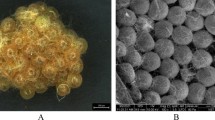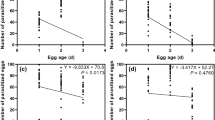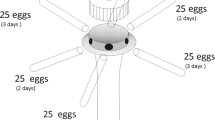Abstract
The use of egg parasitoids in the biological control of insect pests is a promising technique in integrated pest management. However, there is little information on the effects of parasitoid female age and host egg age on parasitization rates specifically on the behaviour of the egg parasitoids such as Trichogramma pretiosum Riley and Telenomus remus Nixon which can have substantial effects on parasitism towards insect pest eggs. Thus, this communication evaluated the relationships between the age of the parasitoid and host egg on the parasitism of Spodoptera frugiperda eggs by T. pretiosum and T. remus in three independent bioassays. In the first and second bioassay, two egg parasitoids (T. pretiosum and T. remus) females were grouped by age in days (ranging from 1–6 and 1–10 days old for T. pretiosum and T. remus, respectively) and were offered 100 eggs of S. frugiperda per treatment for 24 h separately. In the third bioassay, 100 eggs of S. frugiperda of different ages (24, 48 and 72 h old) were offered separately to T. pretiosum and T. remus females for 24 h. The variables such as the number of eggs parasitized, parasitoid emergence (%) and female progeny were evaluated. The results indicated that as the age of the T. pretiosum increases, per cent parasitism and adult emergence decreases but age of T. remus females did not affect the number of S. frugiperda eggs parasitized or the emergence of the progeny. However, the sex ratio was more male-biased in the progeny of 1- and 2-day-old females compared to older wasps in the case of T. remus. In the third bioassay, the highest parasitism was observed in 24- and 48-h-old eggs and the per cent emergence decreased with increasing female age.
Similar content being viewed by others
Abbreviations
- FAW:
-
Fall armyworm
- Sp.:
-
Species
- viz.:
-
Videre licet (synonym for ‘namely’)
- i.e.:
-
That is
- h:
-
Hour
- gm:
-
Gram
- cm:
-
Centimetre
- ml:
-
Millilitre
- L:
-
Litre
- °C:
-
Degree celsius
- RH:
-
Relative humidity
- UV:
-
Ultraviolet
- MARS:
-
Main Agricultural Research Station
- UAS:
-
University of Agricultural Sciences
- IPM:
-
Integrated pest management
- ABC:
-
Augmentative biological control
References
Agboyi LK, Layode BF, Fening KO, Beseh P, Clottey VA, Day R, Kenis M, Babendreier D (2021) Assessing the potential of inoculative field releases of Telenomus remus to control Spodoptera frugiperda in Ghana. InSects 12(8):665
Bueno RCODF, Carneiro TR, Pratissoli D, Bueno ADF, Fernandes OA (2008) Biology and thermal requirements of Telenomus remus reared on fall armyworm Spodoptera Frugiperda Eggs. Cienc Rural 38(1):1–6
Cave RD (2000) Biology, ecology and use in pest management of Telenomus remus. Biocontrol News Inf 21(1):21–26
Chormule A, Shejawal N, Sharanabasappa KCM, Asokan R, Swamy HM (2019) First report of the fall armyworm, Spodoptera frugiperda (J. E. smith) (Lepidoptera: Noctuidae) on sugarcane and other crops from Maharashtra, India. J Entomol Zool Stud 7(1):114–117
Deshmukh SS, Kalleshwaraswamy CM, Prasanna BM, Sannathimmappa HG, Kavyashree BA, Sharath KN, Pradeep P, Patil KKR (2021a) Economic analysis of pesticide expenditure for managing the invasive fall armyworm, Spodoptera frugiperda (J. E. Smith) by maize farmers in Karnataka, India. Curr Sci 121(11):1487–1492
Deshmukh SS, Prasanna BM, Kalleshwaraswamy CM, Jaba J, Choudhary B (2021b) Fall armyworm (Spodoptera frugiperda). Polyphagous pests of crops. Springer, Singapore, pp 349–372
Fernandes FL, Bacci L, Fernandes MS (2010) Impact and selectivity of insecticides to predators and parasitoids. Entomo Brasilis 3(1):1–10
Firake DM, Behere GT (2020) Natural mortality of invasive fall armyworm, Spodoptera frugiperda (J. E. Smith) (Lepidoptera: Noctuidae) in maize agroecosystems of northeast India. Biol Control 148:104–303
Ganiger PC, Yeshwanth HM, Muralimohan K, Vinay N, Kumar ARV, Chandrashekara K (2018) Occurance of the New Invasive Pest, Fall Armyworm, Spodoptera frugiperda (J. E. Smith) (Leoidoptera: Noctuidae), in the Maize fields of Karnataka, India. Curr Sci 115(4):621–623
Hutchinson WD, Moratorio M, Martin JM (1990) Morphology and biology of Trichogrammatoidea bactrae (Hymenoptera: Trichogrammatidae), imported from Australia as a parasitoid of pink bollworm (Lepidoptera: Gelechiidae) eggs. Ann Entomol Soc Am 83:46–54
Jaba J, Sathish K, Mishra SP (2020) Biology of fall army worm Spodoptera frugiperda (JE Smith) on artificial diets. Indian J Entomol 82(3):543
Knipling EF (1980) Regional management of the fall armyworm a realistic approach. Fla Entomol 6(3):468–480
Laminou SA, Ba MN, Karimoune L, Doumma A, Muniappan R (2020) Parasitism of locally recruited egg parasitoids of the fall armyworm in Africa. InSects 11(7):430
Laurentis VL, Ramalho DG, Santos NA, Carvalho VFP, Vacari AM, De Bortoli SA, Veneziani RCS, da Costa IG, Dami BG (2019) Performance of Trichogramma pretiosum Riley (Hymenoptera: Trichogrammatidae) on eggs of Helicoverpa armigera (Hubner) (Lepidoptera: Noctuidae). Sci Rep 9(1):1–8
Mahadevaswamy HM, Asokan R, Kalleshwaraswamy CM, Prasad YG, Maruthi MS, Shashank PR, Devi NI, Surakasula A, Adarsha S, Srinivas A, Rao S (2018) Prevalence of “R” strain and molecular diversity of fall armyworm Spodoptera frugiperda (J E Smith) (Lepidoptera: Noctuidae) in India. Indian J Entomol 80(3):544–553
Mallapur CP, Naik AK, Hagari S, Prabhu ST, Patil RK (2018) Status of alien pest fall armyworm, Spodoptera frugiperda (J. E. Smith) on maize in Northern Karnataka. J Entomol Zool Stud 6(6):432–436
Navik O, Shylesha AN, Patil J, Venkatesan T, Lalitha Y, Ashika TR (2021) Damage, distribution and natural enemies of invasive fall armyworm (J E smith) under rainfed maize in Karnataka, India. Crop Prot 55:143–105536
Nidhi K, Joshi M, Pandey R, Anand K (2019) Fall army worm: an invasive pest in India and its management. J Entomol Zool Stud 7(5):1034–1037
Oktaviani, Maryana N, Pudjianto (2021) Telenomus remus (Nixon) (Hymenoptera: Scelionidae) biology and life table on Spodoptera frugiperda (JE Smith) (Lepidoptera: Noctuidae) eggs. In: IOP conference series: earth and environmental science, vol 950. p 012024
Pomari AF, Bueno ADF, Bueno RCODF, Junior M, de Oliveiras A, Fonseca ACPF (2013) Releasing number of Telenomus remus (Nixon) (Hymenoptera: Platygastridae) against Spodoptera frugiperda Smith (Lepidoptera: Noctuidae) in corn, cotton and soybean. Cienc Rural 43(3):377–382
Queiroz APD, Bueno ADF, Pomari-Fernandes A, Bortolotto OC, Mikami AY, Olive L (2017) Influence of host preference, mating, and release density on the parasitism of Telenomus remus (Nixon) (Hymenoptera: Platygastridae). Rev Bras Entomol 61(1):86–90
Queiroz AP, Favetti BM, Luski PG, Gonçalves J, Neves PMOJ, de Freitas BA (2019) Telenomus remus (Hymenoptera: Platygastridae) parasitism on Spodoptera frugiperda (Lepidoptera: Noctuidae) eggs: different parasitoid and host egg ages. Semin Cienc Agrar 40(6):2933–2946
Queiroz APD, Costa CO, Favetti BM, Silva GV, Bueno ADF (2020) Effects of parasitoid and host age on the parasitism of Trichogramma pretiosum on eggs of Anticarsia gemmatalis. Rev Bras Entomol. https://doi.org/10.1590/1806-9665-RBENT-2019-105
Sharanabasappa SD, Kalleswaraswamy CM, Maruthi MS, Pavithra HB (2018b) Biology of invasive fall armyworm, Spodoptera frugiperda (J. E. Smith) (Lepidoptera: Noctuidae) on maize. Indian J Entomol 80:540–543
Sharanabasappa D, Kalleshwaraswamy CM, Poorani J, Maruthi MS, Pavithra HB, Diraviam J (2019) Natural enemies of Spodoptera frugiperda (J E Smith) (Lepidoptera, Noctuidae), a recent invasive pest on maize in South India. Fla Entomol 102(3):619–623
Sharanabasappa SD, Kalleshwaraswamy CM, Asokan R, Mahadevaswamy HM, Maruthi MS, Pavithra HB, Hegde K, Navi S, Prabhu ST, Goergen G (2018a) First report of the fall armyworm, Spodoptera frugiperda (J. E. Smith) (Lepidoptera: Noctuidae), an alien invasive pest on maize in India. Pest Manag Hort Ecosyst 24(1):23–29
Shylesha AN, Jalali SK, Gupta A, Varshney R, Venkatesan T, Shetty P, Ojha R, Ganiger PC, Navik O, Subaharan K, Bakthavatsalam N, Ballal CR (2018) Studies on new invasive pest Spodoptera frugiperda (J. E. Smith) (Lepidoptera: Noctuidae) and its natural enemies. J Biol Control 32(3):1–7
Silva CSBD, Parra JRP (2013) New method for rearing Spodoptera frugiperda in laboratory shows that larval cannibalism is not obligatory. Rev Bras Entomol 57(3):347–349
Sultan R, Khan J, Haq E, Mehmood T, Khattak RZ, Akhtar N (2013) Biological parameters of Trichogramma chilonis Ishii (Trichogrammatidae: Hymenoptera) feeding on Sitotroga cerealella eggs at three constant temperatures. Pak J Agric Res 26(1):65–70
Tefera T, Goftishu M, Ba M, Muniappan R (2019) A guide to biological control of fall armyworm in Africa using egg parasitoids, 1st edn. Virginia Tech, Nairobi
Van Lenteren JC, Bolckmans K, Kohl J, Ravensberg WJ, Urbaneja A (2018) Biological control using invertebrates and microorganisms: plenty of new opportunities. Biocontrol 63(1):39–59
Acknowledgements
The authors are thankful to the Dr.Chandish Ballal, Ex-Director, Dr. Y. Lalita, Chief Technical Officer and Dr. Richa Varshney, Scientist, ICAR-NBAIR, Bengaluru for the support, guidance and providing parasitoids culture.
Author information
Authors and Affiliations
Contributions
AH, PA, SH and MK: conceptualization and manuscript editing, VK: experimentation, original data collection and draft writing, VK and AH: data curation, SSD: manuscript reviewing and editing. All authors read and approved the final manuscript.
Corresponding author
Ethics declarations
Conflict of interest
No conflict of interest was reported by the authors.
Additional information
Publisher's Note
Springer Nature remains neutral with regard to jurisdictional claims in published maps and institutional affiliations.
Rights and permissions
Springer Nature or its licensor (e.g. a society or other partner) holds exclusive rights to this article under a publishing agreement with the author(s) or other rightsholder(s); author self-archiving of the accepted manuscript version of this article is solely governed by the terms of such publishing agreement and applicable law.
About this article
Cite this article
Veena, K., Hosamani, A., Prabhuraj, A. et al. Efficiency of female age of egg parasitoids on parasitism of Spodoptera frugiperda (J. E. Smith) (Lepidoptera: Noctuidae) eggs of various ages. J Plant Dis Prot 131, 471–478 (2024). https://doi.org/10.1007/s41348-023-00845-2
Received:
Accepted:
Published:
Issue Date:
DOI: https://doi.org/10.1007/s41348-023-00845-2




